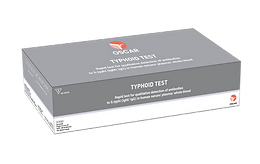Typhoid
Typhoid fever is a life-threatening infection caused by the bacterium Salmonella Typhi. An estimated 11–20 million people get sick from typhoid and between 128,000 and 161,000 people die from it every year. Typhoid is prevalent parts of Asia (especially India, Pakistan, and Bangladesh), Africa, the Caribbean, Central and South America, and the Middle East.
About
Once Salmonella Typhi bacteria are eaten or drunk, they multiply and spread into the bloodstream. It is usually spread through contaminated food or water, hence are most common in parts of the world with poor sanitation. Two vaccines have been used for many years to prevent typhoid. Practicing safe eating and drinking habits can also prevent the disease.
Diagnosis
Current diagnosis for typhoid is still via the method of culture and antibody detection by means of the Widal test. Isolation of Salmonella typhi has remained as the gold standard, with culture from the bone marrow aspirate or a combination of specimens from blood, stool or urine
Prognosis
Typhoid fever and paratyphoid fever have similar symptoms̵. People usually have a sustained fever (one that doesn’t come and go) that can be as high as 103–104°F (39–40°C). Typhoid fever can be treated with antibiotics although increasing resistance to different types of antibiotics is making treatment more complicated.
